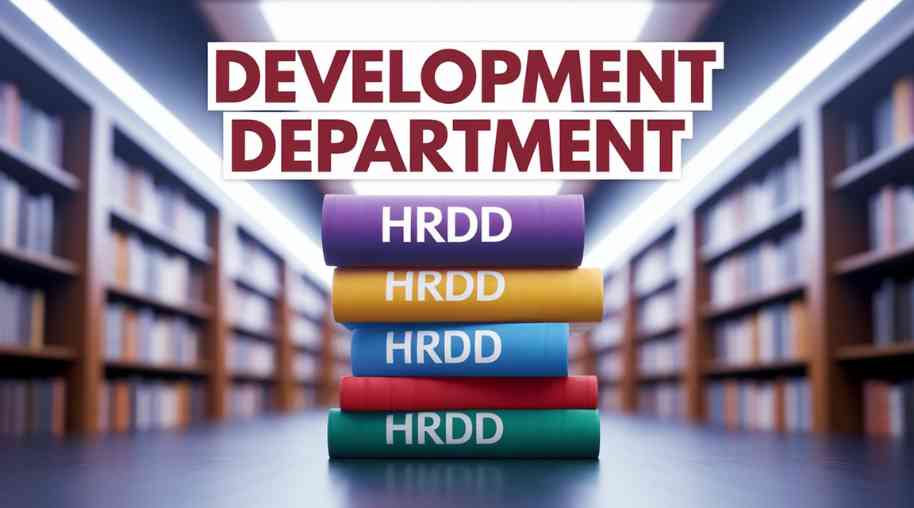HRDD Full Form-Human Resources Development Department
by Shashi Gaherwar
0 2172
The Role of Human Resources Development in Organizational Success
In today’s competitive business landscape, organizations must invest in their employees to remain relevant and successful. Human Resources Development (HRD) plays a crucial role in shaping a skilled, motivated, and adaptable workforce. By focusing on continuous learning, training, and career progression, HRD fosters employee growth while ensuring long-term organizational success. This article delves into the importance, key components, and benefits of HRD in modern businesses.

What is Human Resources Development (HRD)?
Human Resources Development refers to a structured framework for improving employee skills, knowledge, and capabilities within an organization. It encompasses various initiatives, including training programs, professional development, mentoring, and leadership training. HRD goes beyond recruitment and employee management by focusing on the continuous growth of individuals, which ultimately strengthens the entire organization.
Key Components of HRD
- Training and Development
- Training programs help employees acquire new skills and enhance existing ones.
- Organizations conduct in-house training sessions, workshops, and e-learning courses to keep employees updated with industry trends and technological advancements.
- Career Development
- HRD includes career planning and growth opportunities for employees.
- Career development programs, succession planning, and mentorship initiatives encourage employees to advance within the company.
- Talent Management
- Effective talent management ensures that the right employees are in the right roles.
- HRD helps in identifying high-potential employees, developing their skills, and preparing them for leadership roles.
- Performance Management
- Regular performance evaluations and feedback mechanisms help employees improve their productivity.
- HRD frameworks include performance appraisal systems that assess employee progress and identify areas for development.
- Leadership Development
- Organizations must invest in leadership training programs to build strong management teams.
- Leadership development programs prepare employees for supervisory roles and enhance decision thrilled-making skills.
- Workforce Planning and Organizational Development
- HRD aligns workforce strategies with business objectives, ensuring that companies have the right talent to meet current and future needs.
- This involves succession planning, restructuring, and fostering a culture of innovation.
Benefits of HRD
- Increased Employee Productivity
- A well-trained workforce is more efficient and productive.
- Employees who receive proper training can perform their tasks with greater accuracy and confidence.
- Higher Employee Satisfaction and Retention
- Organizations that invest in employee development create a positive work environment.
- Career growth opportunities enhance job satisfaction, reducing turnover rates.
- Enhanced Organizational Performance
- When employees improve their skills, organizations experience growth in efficiency, innovation, and overall performance.
- HRD contributes to achieving business goals and staying ahead of competitors.
- Improved Employee Engagement
- Employees feel more valued and engaged when companies invest in their development.
- Engaged employees are more committed to their work and contribute positively to the organization’s success.
- Adaptability to Industry Changes
- In rapidly evolving industries, HRD helps employees stay updated with new technologies, regulations, and best practices.
- This ensures that the organization remains competitive in the market.
Challenges in HRD and Solutions
- Resistance to Change
- Some employees may resist new training programs or career development initiatives.
- Organizations should emphasize the benefits of learning and create a supportive environment for professional growth.
- Limited Resources
- Smaller businesses may struggle to invest in extensive HRD programs.
- A cost-effective solution is leveraging online training platforms and cross-training employees internally.
- Measuring Effectiveness
- Assessing the impact of HRD programs can be challenging.
- Companies should establish clear metrics, conduct feedback surveys, and analyze performance data to measure success.
Human Resources Development is a vital component of any successful organization. By fostering continuous learning, skill enhancement, and leadership development, HRD contributes to employee satisfaction and overall business growth. Investing in HRD not only benefits individuals but also creates a more competitive and innovative organization. In an era of rapid change, companies that prioritize HRD will remain resilient and adaptable to the evolving business landscape.
Further Learning Resources
If you’re passionate about building a successful blogging website, check out this helpful guide at Coding Tag – How to Start a Successful Blog. It offers practical steps and expert tips to kickstart your blogging journey!
For dedicated UPSC exam preparation, we highly recommend visiting www.iasmania.com. It offers well-structured resources, current affairs, and subject-wise notes tailored specifically for aspirants. Start your journey today!

Share:








Comments
Waiting for your comments